Wielding bowie knife memes and pics of the Family Proclamation, members of the Deseret Nation call “apostate” members of The Church of Jesus Christ of Latter-day Saints to repentance. Although the social media hashtag #DezNat is a relatively recent phenomenon, the loosely-knit group and its activities reflect a broader tradition of vigilantism in the history of the Church.
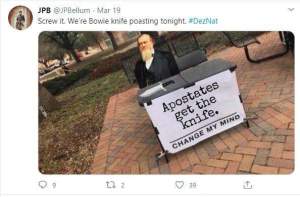
Background of #DezNat
The #DezNat hashtag first appeared on Twitter in August 2018. It was coined by John Paul Bellum (@JPBellum) referring to “Deseret Nation.” Inspired by the idea of the theocratic State of Deseret planned by early Latter-day Saint leaders, Bellum desired to carve out a spot on social media “that would be welcoming to all who were willing to build the kingdom and defend the church and its leaders online.”
The hashtag serves several purposes. It can be used to share uplifting gospel messages and “dank” memes with likeminded individuals. It can also serve as a sort of batsignal, calling upon a cloud-based militia to help beseiged colleagues or organize against perceived rising threats to the church and its members. These enemies can be ideological (pornography, secularism, feminism, LGBTQ+ movements, black lives matter movement, etc.) or actual individuals.
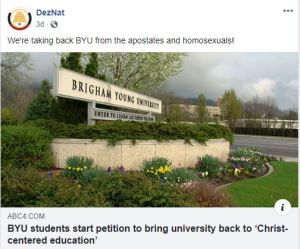
Often #DezNat categorizes individuals as “progmos” (progressive Latter-day Saints), “exmos” (former Latter-day Saints), and “antimos” (antiMormons). Members of the Church who faithful but not as enlightened as DezNat are called “mormies.”
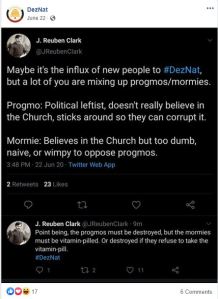
Two symbols that the group uses hearken back to the historical Deseret. One is the blue and white 1877 version of the Deseret flag, a variation of one currently flying at Ensign Peak in Salt Lake City.[fn1] The other is a circular patch depicting the angel Moroni, the previous symbol of The Church of Jesus Christ of Latter-day Saints, surrounded by the common Utah pioneer phrases “Holiness to the Lord” and “Industry” written in the unique Deseret alphabet.
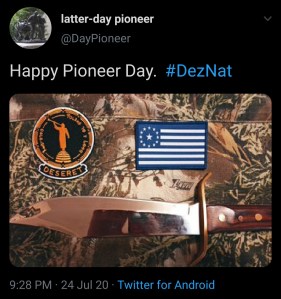
Another symbol used by the group is the Bowie knife. In “The Official #DezNat User Guide” at the blog Teancum’s Javelin, Bellum explained why the group chose to embrace the symbol.
One particularly famous speech Brigham Young gave involved him reportedly unsheathing a large Bowie knife and placing it on the pulpit, theatrically threatening all apostates who were harassing the church and its members to leave the territory or be driven out. This story is often used by church opponents to show how Brigham Young was “a terrible man bent on violently enforcing his dictatorial power in his oppressive theocratic regime.” Some users of the hashtag, including me, used this story in memes and jokes in order to show how absurd the church’s detractors were and how unafraid we were to embrace our history, even the ugly parts.
J. P. Bellum, “The Official #DezNat User Guide,” Teancum’s Javelin
Images of weaponry are common in DezNat memes. Often weapons are photoshopped on to pictures of Brigham Young (and sometimes other church leaders).


The movement fights any negative speaking of church prophets, past or present. You’ll often see the phrase “Brigham Young Did Nothing Wrong” (#BYDNW), a riff off the more common trolling memes “Hitler Did Nothing Wrong” and “Thanos Did Nothing Wrong.”
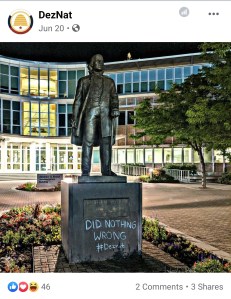
It is not uncommon to see threatening memes with the #DezNat hashtag implying or outright stating that apostates (including “progmos” and “exmos”) should be killed. DezNat heroes include the Book of Mormon figures Teancum (with his signature javelin) and Captain Moroni, noted for their militant zeal.

Besides Brigham Young, another DezNat favorite from Church History is the infamous gunslinger Porter Rockwell. Rockwell was a close friend of Joseph Smith who bore the nickname “Destroying Angel of Mormondom.” He famously said that he “never killed anyone who didn’t need killing.”
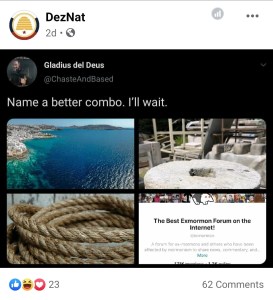
Users of the hashtag are unapologetic about the abrasive tactics. Bellum explains, “#DezNat may not be to everyone’s taste. Those who use the hashtag can be combative, rude, crass, aggressive, even mean. However, one thing you will never have to worry about with #DezNat is that when the prophet speaks, we listen, and when he directs, we obey.”
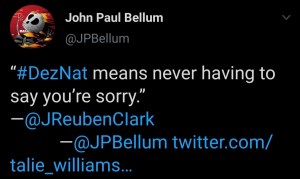
Church History Parallels
Some have compared DezNat to the Danites, an infamous vigilante band of Latter-day Saints that operated for a few months in 1838. A Church History topic essay states that their “objective was to defend the community against dissident and excommunicated Latter-day Saints as well as other Missourians.” The essay further explains that members of that group were “absorbed into militias largely composed of Latter-day Saints” during the Mormon-Missouri War.
These militias clashed with their Missouri opponents, leading to a few fatalities on both sides. In addition, Mormon vigilantes, including many Danites, raided two towns believed to be centers of anti-Mormon activity, burning homes and stealing goods.
“Danites,” Church History Topics
“Whittling and Whistling” in Nauvoo
I tend to see DezNat tactics as more like the short-lived “whittling and whistling” movement of Nauvoo. One of the volume editors with the Joseph Smith Papers, Jeffrey D. Mahas, wrote an article for the Journal of Mormon History in 2017 describing the group and its context within the widespread vigilantism of the time.[fn2] After the repeal of the Nauvoo charter in early 1845, the city was left without a police force. Latter-day Saints were “concerned that anti-Mormons would take advantage of the lack of civil government in Nauvoo to arrest Church leaders as they had the Smiths.”[fn3]
In March, Brigham Young organized a force according to an ecclesiastical structure. In each ward, “quorums of bishops and deacons” were organized. A “bishop” would supervise twelve deacons. These bishops were then presided over by the “archbishop,” who was the traditional ecclesiastical head of the ward.[fn4] The bishops and deacons were to “avoid overt physical violence,” instead expelling dissenters and suspicious outsiders via intimidation. “According to the participants and victims of these whistling schools, Mormon intimidation tactics consisted of having deacons follow undesirables while whistling and whittling with bowie knives.”[fn5]
Initially, the whistling and whittling companies were composed of adult men “holding the priesthood offices of Seventy and high priest.” By mid-April, however, the companies began to be dominated by youth, some “as young as twelve.”[fn6] Brigham Young expressed displeasure at this development, and privately instructed the high priests that “boys were not to attend to the duties of deacons. That duty must be done by men of experience.”[fn7]
The shortlived “whistling and whittling” experiment quickly became a liability. Not only did the unruly young mobs running through the streets reflect badly on “the children of Zion”[fn8] (and their parents), wide reporting of the vigilante activity “led to increased popularity for the anti-Mormon cause outside the city.”[fn9]
Brigham Young later brought the issue to the church members generally.
On May 4, Brigham Young took his complaints public and condemned the whistlers before a large outdoor worship service. While he insisted that the Saints continue preparations for a possible antiMormon assault on Nauvoo, he counseled them to “be peacable, [and to] att[en]d to their own bus[iness].” Speaking to the ecclesiastical structure of the vigilante companies, he said, “I expect the Bishops & the Deacons… I want you to let every body alone if they keep out of your path.” He condemned the “gang of boys running thro’ the Streets,” and said that he would “put a stop to such work.”
Jeffrey David Mahas, “‘I Intend to Get Up a Whistling School’: The Nauvoo Whistling and Whittling Movement, American Vigilante Tradition, and Mormon Theocratic Thought,” Journal of Mormon History, Vol. 23, No. 4 (October 2017) 65-66.
Shortly thereafter, Brigham Young ordered the old police force unofficially back on duty in Nauvoo.
Vigilante Activities in Utah
The #DezNat movement itself cites Brigham Young’s inflammatory rhetoric during the Utah period as inspiration. The use of Bowie knives to remedy apostate threats is a throwback to a sermon by Brigham Young given in Salt Lake City on 27 March 1853.
I say, rather than that apostates should flourish here, I will unsheath my bowie knife, and conquer or die. [Great commotion in the congregation, and a simultaneous burst of feeling, assenting to the declaration.] Now, you nasty apostates, clear out, or judgment will be put to the line, and righteousness to the plummet. [Voices, generally, “go it, go it.”] If you say it is right, raise your hands. [All hands up.] Let us call upon the Lord to assist us in this, and every good work.
Brigham Young, 27 March 1853, Journal of Discourses, Vol. 1, p. 83
Probably the most famous example of vigilante violence in Utah was the Mountain Meadows Massacre. In September 1857, Latter-day Saints in Southern Utah planned and carried out an attack on a wagon train on its way to San Bernardino, California. Over a hundred men, women, and children were brutally killed. Church historians in recent decades have closely examined the historical records and concluded that while high-ranking Church leaders like Brigham Young and George A. Smith did not order or approve of such acts, the fiery rhetoric likely contributed to a volatile situation.[fn10]
The Church eventually began to push back against its widespread public image as a violent religion. In 1889, the First Presidency and the Quorum of the Twelve Apostles released an official statement.
We denounce as entirely untrue the allegation which has been made, that our Church favors or believes in the killing of persons who leave the Church or apostatize from its doctrines. We would view a punishment of this character for such an act with the utmost horror, it is abhorrent to us and is in direct opposition to the fundamental principles of our creed.
“Peace and Violence Among 19th Century Latter-day Saints,” Gospel Topics Essay, footnote 45.
In recent years, Church leaders have again denounced inflammatory rhetoric. “The Church of Jesus Christ of Latter-day Saints condemns violent words and actions and affirms its commitment to furthering peace throughout the world.”
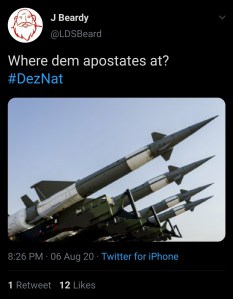
I guess DezNat folks never got the memo.
Discuss
ETA: Lead image is a screenshot from the Weekly Hoss YouTube video episode 14: BLM ANTIFA Attempted MURDER in Provo? Was Brigham Right? What is DezNat?
[fn1] The flag at Ensign peak has blue stars on a white field. The flag used by DezNat has white stars on a blue field. It is the same flag used by the micronation Commonwealth of Deseret founded in 2012.
[fn2] Jeffrey David Mahas, “‘I Intend to Get Up a Whistling School’: The Nauvoo Whistling and Whittling Movement, American Vigilante Tradition, and Mormon Theocratic Thought,” Journal of Mormon History, Vol. 23, No. 4 (October 2017) 37-67.
[fn3] Mahas, “Nauvoo Whistling and Whittling,” 48.
[fn4] Mahas, “Nauvoo Whistling and Whittling,” 53-55.
[fn5] Mahas, “Nauvoo Whistling and Whittling,” 56.
[fn6] Mahas, “Nauvoo Whistling and Whittling,” 61.
[fn7] Mahas, “Nauvoo Whistling and Whittling,” 62.
[fn8] Mahas, “Nauvoo Whistling and Whittling,” 63.
[fn9] Mahas, “Nauvoo Whistling and Whittling,” 60.
[fn10] “Peace and Violence Among 19th Century Latter-day Saints,” Gospel Topics Essay. Words in red were added 8/8/20 to clarify that I was speaking of general church leaders rather than local church leaders like Isaac Haight. I appreciate commenter Wondering pointing out the inaccuracy.

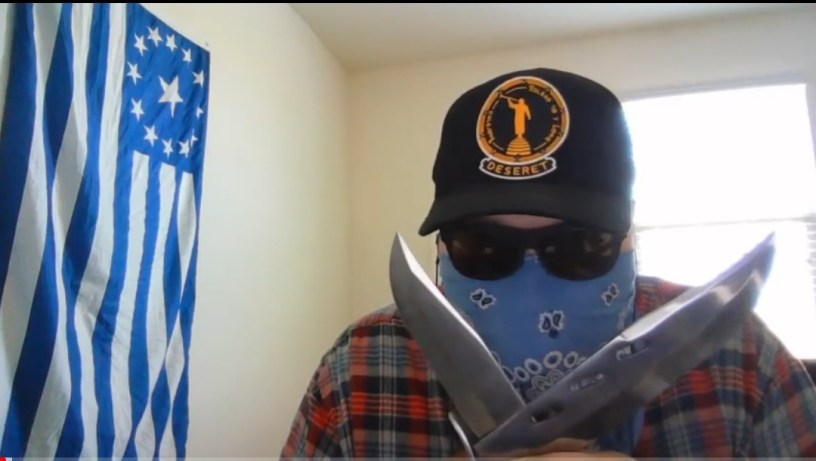
Mary Ann, Thank you for your research and your post. I also guess they didn’t get the memo.
I did find this curious with respect to the Mountain Meadows massacre: “Church leaders did not order or approve of such acts”
“Church leaders” is a bit too broad for my taste. The essay you footnoted, itself, acknowledges that Isaac Haight, a stake president, ordered the attack and that “A series of tragic decisions by local Church leaders—who also held key civic and militia leadership roles in southern Utah—led to the massacre,” concluding with an exaggeration “Throughout the Church’s history, Church leaders have taught that the way of Christian discipleship is a path of peace.” It might have been more accurate if that essay conclusion had said “some Church leaders” or “at times throughout the Church’s history.”
I have wondered sometimes how good early Utah Mormons were at distinguishing between the various capacities in which Church leaders acted — whether Isaac Haight or Governor Brigham Young.
Are these the people behind the vague petition about BYU referred to at Melinum Star?
Right wing terrorists in the church? I wonder who they vote for? Moral vacume!
Wondering,
Whoops. You are correct. Local church leaders definitely had a role in the massacre. I’ll edit that in the post.
Geoff-Aus,
They are not behind the petition, though many of them obviously support it. The petition was created by two BYU students, Hanna Seariac and Tristan Mourier. Seariac runs a podcast for FairMormon and also blogs for them. Her main motivation is that they would not allow a pro-life club on campus. French student Tristan Mourier gained some notoriety when he decided to read the Family Proc at those protesting BYU’s honor code with the whole LGB holding hands/kissing thing earlier this year.
Geoff-Aus,
As far as politics goes, DezNat folks claim to disagree with each other on that. I tend to see politically conservative and/or libertarian thinking in a lot of their posts, so I’d guess that a good percentage voted for Trump. Many people have classified the group as part of the “alt right,” but I don’t think it’s accurate. Admittedly, they use a LOT of the same terminology as the alt right, with similar imagery and aggressive tactics. I’ve seen the DezNat Facebook page repost one meme from an alt right group (talking about how our ancestors aren’t evil). There is widespread support for the #tradwife movement and SO MUCH redpill culture (reclaiming traditional masculinity and classifying men as Chads/Alphas versus Virgins/Betas). Again, they point to the Family Proc and traditional church teachings to reinforce 1950’s style male/female spheres and heteronormativity. They can be INCREDIBLY virulent against members of the LGBTQ+ community.
But, I’ve only seen one of the DezNat folks ever talk about white culture. Their arguments against the Black Lives Matter movement seem to be based more on what they see as destruction of the nuclear family and general distrust of secularism and political correctness. Any charges of racism against the movement in general would really fall on their overt support of racist actions and statements from previous church leaders, which derives more from their ideology to never speak negatively of prophets, past and present. They claim to represent a range of ethnicities.
The big thing is rejection of identity politics. Like a lot of political conservatives (and church leaders), problems like racism are because of the bad actions of individuals rather than systemic issues. Progressives and exmos want to change the church to justify PERSONAL sin. I think that’s why they don’t have a problem labeling and targeting specific “apostates.” (Because judging other people is fine as long as it’s righteous judgment, per the Joseph Smith Translation. Judging past church leaders and current church structure cannot, in their view, EVER be righteous judgment. That’s just pride.)
I apologize for the crudeness, but every time I see DezNat, I read it as Deez Nuts. But then again, I suppose adherents to DezNat have about the same level of maturity as 11 year olds.
Pardon the crudeness, but every time I see DezNat, I read it as Deez Nuts, but then again, I suppose any adherent to DezNat has the maturity of an 11 year old.
(also apologies if I’ve double posted).
Nice write-up. I have been wondering about the devnat hashtag. I think I’ve also seen a bumper sticker. I didn’t know what it was referring to.
And the bit about Porter Rockwell…. I was already considering using a new pseudonym, but now I have more motivation.
Young tribal males + testosterone = stupidity
P,
Yeah, I guess that’s why I believe the best comparison is the whittling and whistling squad in Nauvoo when it was getting out of hand. These DezNat guys work to be as intimidating as possible (without actually physically following through on any threats as far as I can tell) to try to carve out a “safe space” for church members online. But they end up just feeding harmful stereotypes. The Danites, whistling brigade, and Utah vigilante activities haunted the Church for years, feeding antiMormon arguments. I mean, we’ve joked in recent years about the “Mormon Mafia,” but some people actually believe the conspiracy junk.
DezNat may like to view themselves as latter-day Teancums or Captain Moronis, but to me they seem more like the people in 3 Nephi 7:
“And the people were divided one against another; and they did separate one from another into tribes…”
I had never heard of these clowns. (OK, I lie, I had heard the name but didn’t know what they were about). So thanks for posting about them. I now have them on my radar.
They seem like an alt-light Mormon group. I’m sure many of them are aware of the infamous Mormon (now former) alt-right blogger Ayla Stewart (aka Wife with a Racist Purpose) and how she was banned from Twitter and indirectly denounced by the church leadership. So they have to be even more cryptic in their messaging. From the looks of it, I doubt we would have to scratch too hard to find that in their core, Deez Nuts wannabees are racists and white supremacists. Groups like these are dangerous. The church leaders need to be on the lookout and find any opportunity they can to call them out.
I went on the DezNat Twitter page and, sure enough, this article is trending, as are the comments. Hi guys. Did a big, bad mean progressive say something mean to you to hurt your feelings? Oh, so sorry. Go cry to mommy now. Pathetic snowflakes.
John W,
I appreciate the support,, but I’d like to keep this conversation on a bit higher level if possible.
I am actually disappointed you didn’t reach out to me or any other users of the #DezNat for more information. I also find it interesting that you didn’t take time to go through the @DezNatRtBot account to see for yourself that the “mean vigilante” posts are less than 10% of what is posted with the tag. Your journalistic skill is lacking and it shows.
As for me, I’ll add that DezNat has strengthened my testimony and the user of the hashtag as a whole encourage me to be better and more faithful every day.
When I’ve seen this DezNat thing, I’ve assumed that it’s just our debased political culture of social media and ignorant populism, now in a Mormon flavor. But the comparison to the whittling and whistling squad is interesting. In Nauvoo, the group devolved into literally childish activity when children took it over. DezNat appears to consist of grown men choosing to act childishly as they pretend that playing with knives, trolling, and bullying are religious activities. In both cases, the whole project discredits and undermines the values that the people involved claim to defend.
We have a fairly grim history of vigilantism in our church, but it’s hard to take DezNat seriously as vigilantes unless we see actual violence from them. They are posers. It seems to me that if they stand for anything, they stand for a program of demeaning faith by turning it into a silly game.
Thanks for the write up, and comments. I’ve seen this hash tag pop up quite a bit, and it’s nice to learn some of the background.
There seems to be a lot of similarity between this group and the Zealots in New Testament times. Zealots we’re a faction of Jews who were willing to use violence to keep the Jewish people “pure” from idolatry, and took as their model Phineas and Elijah from the Bible, both of which suggested that God sanctioned extreme measures to keep the covenant people from being “polluted” by heretics and those encouraging subtle or explicit idolatry. (Paul was a zealot, which explains his persecution of Christians, and there’s a great chapter on the movement in NT Wright’s biography of him.) This seems similar: a desire to keep Latter-day Saints pure from “progressive” ideas, willing to use more modern, rhetorical strategies (including rhetorical “violence”). I don’t know as much about vigilantism in Utah, but the Danites and others like them seem to be heirs to that even older tradition.
I might be off, but I would bet the brethren are more concerned with wackos like DezNat folk than they are of any progmo site like W&T. I would rather my kids become atheists than fundamentalists or DezNat types. They are mostly unheard of by the mainstream, much like Mormon Stories is, so they are relatively harmless. Their rhetoric can lead to crazies taking it too far. I am reminded of the Charlie Hebdo incident when some nut jobs went and killed a dozen people for printing a caricature of Mohammed. To be fair, the rhetoric of the exmo crazies could have the same affect. They have a #BITFDWT hashtag that might incite violence in some chemically imbalanced angry person. I think it is awesome all these comments are getting downvoted. It must mean they are here checking it out. While you guys are here, go check out Mary Ann’s posts from 2017 and 2018. They are the best this site has to offer. When you get done, put down your Bowie knives and go put your camouflage back on and get back to your grown man air soft gun wars.
Here’s a list you can sign up for on twitter- it blocks you from seeing or being seen by accounts that use the DezNat hashtag.
https://mobile.twitter.com/BlockDNat/status/1283685983314046981?s=20
And here I thought all Along it was a spoof on Deez Nuts.
Thanks for the info!
Just an aside regarding the #BITFDWT hashtag that was popular at one point at r/exmormon: there was plenty of pushback from inside that crowd, motivated by the same concerns expressed in an earlier comment here.
The attention to taxonomies in our various spaces can be amusing (“mormies” is admittedly kinda clever) but if you ever see r/exmormon slipping into a kind of deluded solipsistic headspace that too closely resembles DezNat for comfort, please write a similar post and call us out.
Thankfully, religious associations remain largely voluntary and as fraught as our own exits might be, it’s a dangerous (mostly in the mental health sense) game to amplify the significance of our goofy taxonomies (exmo, NOM, TBM, etc) to such an absurd level that we forget our shared humanity and individual free agency.
That Flag Account: I feel like 10% “mean vigilante posts” is a lot!
Bryan,
(Sorry, I had to fish your comment out of the spam filter.) Yes, they definitely saw themselves as part of an older biblical tradition. The Danites originally called themselves “the society of the Daughter of Zion,” which was believed to be a reference to Micah 4:13. Their constitution was also heavily influenced by early American revolutionaries. I recommend this 2008 post and the comment thread over at the Juvenile Instructor for more info: https://juvenileinstructor.org/danite-constitution/
I’m back. Sorry. This post is very popular at r/mormon and r/exmormon at the moment. The author here did a fantastic job of taking on a topic (and a demographic) that we’re typically too busy/too uninterested to engage in a serious/thorough way, so kudos for that, OP.
That said. Since I expect some DezNat types will likely be wandering by this comments section, I’d like to share my view of their hijinx:
More than anything, these DezNat characters remind me of Scientology‘s “squirrel busters” (members of the Church of Scientology who go around being rude to former members):
Congrats on making your church look like a cult, DezNats.
Mary Ann, thanks for this information. I didn’t know much about the whistling & whittling brigade, but obviously, the early Church was in many communities with a reliable law enforcement gap. That BY only objected when children were included was interesting to learn, although boys as young as 12 were able to be invited to receive the endowment. Apparently there were mixed feelings on the maturity level of 12 year old boys (I had mixed feelings on the maturity level of 19 year olds when I was on my mission, and then the Church revised the age downward for boys. YIKES).
I found it interesting that you didn’t see a strong like to anti-racism, or not on par with the anti-LGBT ideology. If that’s the common thread, then by their reckoning BYU is lowkey progmo (not BYU-I). I’ve heard that Oaks is concerned that not enough professors are fighting strongly enough against gay rights, although that’s a total rumor (that would surprise me zero–he’s clearly flipped a switch on gay rights since the mid-90s when he supported gay unions including partner benefits so long as it wasn’t called marriage). That’s something I heard a few years ago, either during or maybe even before the PoX.
Mary Ann, thank you for your work here. I just became aware of this group, and I will be writing about them myself. I appreciate your research here, and I will be sure to reference you! I’ve already shared this on my Facebook page.
It may be that this group is not entirely alt-right as a unified front, but the use of alt-right and incel forms of slang and thought is dangerous. This is not a group that can be allowed to live unchallenged. As a gay man, this group represents an existential threat.
Anyway, as said, I appreciate this article, and I hope we can present a strong, united front in combating this plague while it is still young.
they also delete any comments that get them too on the nose. Petulant children
Well, looks like I poked #DezNat a few too many times, and am now getting the ‘squirrel buster’ treatment over on their Facebook page… https://www.facebook.com/DeseretNation/ … pretty gross stuff but the pedo accusation seems like a familiar go-to script in their world. I was mostly curious as to the extent of that FAIRMormon podcast host in all of this, and this pretty much settles that, as she led the charge in this latest round of hijinx.
It is my experience that right of centre church blogs are not into free speach. My responses do not appear on any right wing blogs I watch, to try not to be in a bubble.
There is a blog that has affiliated itself with Deseret Nation: Mormon Chronicle. They are beyond far-right.
John Taber,
Wow. That blog is something. Just to be clear for others who see this, John was talking about this blog:
https://www.mormonchronicle.com/
This should not be confused with an older blog by Clair Barrus that was active from 2006-2013 called Mormon Chronicles: http://mormon-chronicles.blogspot.com/?m=1
Barrus replaced that blog with the current website Today in Mormon History: http://www.todayinmormonhistory.com/?m=1
Thanks for providing that clarification Mary Ann. 🙂
Follow up to this post and the work Mary Ann has done in helping to understand this group that has sprung up among us:
https://www.theguardian.com/us-news/2021/jul/21/alaska-assistant-attorney-general-twitter-far-right
“Even from a skilled brush, Idiot is a color that redly splatters onto the painter.”
I attended a church school for a couple of years. To do so, as an adult I signed a contract agreeing to behave in such and such a way. I followed through with my end of the agreement and so did the school. At the end of the second year, we parted ways, and I swore in my wrath that neither I nor my children would ever again attend a church school. For the most part in the interceding 40 years, we haven’t. My definition of an idiot is anyone who signs a contract without the intent to follow through.
Cougism is not Mormonism. Rather, it is a benighting ideology. Coug Hill is a private enclave and can impose into the member contract pretty much whatever rules it wants. Let the market decide its fate. There are thousands of better, certainly cheaper, schools available for a college education. If you feel your tax dollars are ill-used at BYU, take that up with your congress-it. A reformed BYU would only be a pig with lipstick.